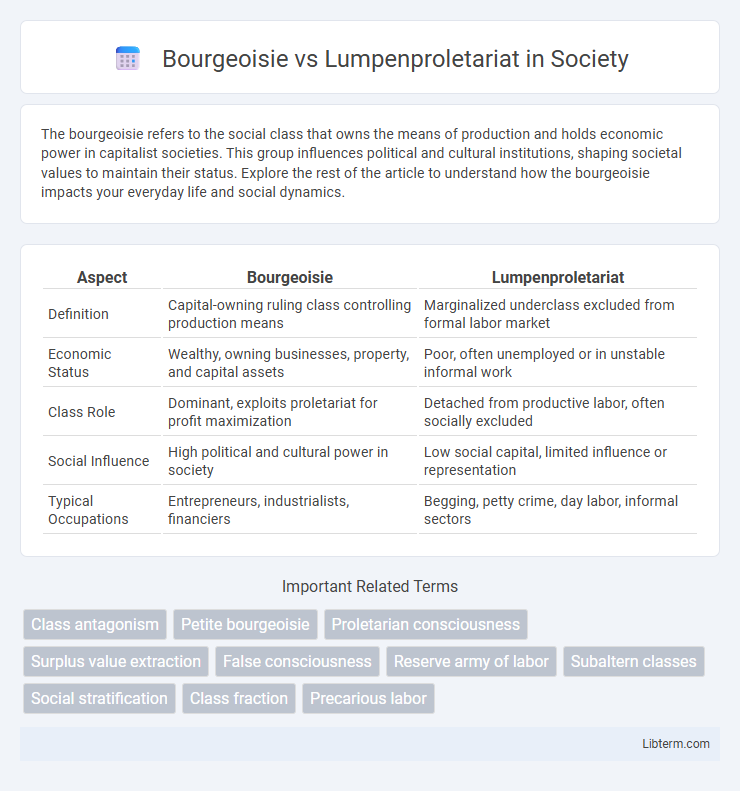The bourgeoisie refers to the social class that owns the means of production and holds economic power in capitalist societies. This group influences political and cultural institutions, shaping societal values to maintain their status. Explore the rest of the article to understand how the bourgeoisie impacts your everyday life and social dynamics.
Table of Comparison
| Aspect | Bourgeoisie | Lumpenproletariat |
|---|---|---|
| Definition | Capital-owning ruling class controlling production means | Marginalized underclass excluded from formal labor market |
| Economic Status | Wealthy, owning businesses, property, and capital assets | Poor, often unemployed or in unstable informal work |
| Class Role | Dominant, exploits proletariat for profit maximization | Detached from productive labor, often socially excluded |
| Social Influence | High political and cultural power in society | Low social capital, limited influence or representation |
| Typical Occupations | Entrepreneurs, industrialists, financiers | Begging, petty crime, day labor, informal sectors |
Defining the Bourgeoisie: Origins and Characteristics
The bourgeoisie originates from the medieval merchant class whose wealth and influence grew during the rise of capitalism, characterized by ownership of means of production and control over capital. This class plays a central role in capitalist economies by driving economic activity, shaping market relations, and enforcing property rights. Key traits include accumulation of surplus value through exploitation of labor, fostering industrial innovation, and maintaining social leverage via legal and political institutions.
Who Are the Lumpenproletariat? Class Profile Explained
The lumpenproletariat consists of marginalized individuals outside the traditional working class, often including the homeless, criminals, and those in irregular employment. Unlike the bourgeoisie, who own means of production and hold economic power, the lumpenproletariat lacks stable employment and class consciousness, making them less likely to participate in organized labor movements. This social group occupies a precarious position in capitalist societies, frequently exploited yet disconnected from proletarian revolutionary potential.
Historical Roots: Marxist Theory of Social Classes
The bourgeoisie, defined in Marxist theory as the capitalist class owning the means of production, emerged during the transition from feudalism to industrial capitalism, consolidating economic power through control of factories and markets. The lumpenproletariat, described by Marx as the socially marginalized and economically disenfranchised group, includes individuals such as beggars, criminals, and the unemployed, who lack stable employment and class consciousness. Historical roots in Marxist class theory position the bourgeoisie as the dominant ruling class exploiting the proletariat, while the lumpenproletariat is seen as a residual class with ambiguous revolutionary potential due to its detachment from traditional labor structures.
Economic Power of the Bourgeoisie in Society
The bourgeoisie wields significant economic power through ownership of capital, control over production means, and influence over market dynamics, enabling them to shape societal wealth distribution and labor relations. This elite class commands resources that determine economic policies and investment flows, reinforcing their dominant position. In contrast, the lumpenproletariat, lacking stable employment and assets, remains economically marginalized and socially disadvantaged.
Social Marginalization of the Lumpenproletariat
The lumpenproletariat, often comprising the chronically unemployed, homeless, and marginalized groups, experiences profound social exclusion and economic disenfranchisement distinct from the bourgeoisie who control capital and production. Unlike the proletariat engaged in wage labor, the lumpenproletariat occupies a precarious position outside traditional labor markets, intensifying their vulnerability to poverty, crime, and social stigma. This systemic marginalization inhibits social mobility and integration, reinforcing barriers that exclude the lumpenproletariat from participating in mainstream economic and political structures.
Political Influence: Bourgeoisie vs Lumpenproletariat
The bourgeoisie wields significant political influence through economic power, ownership of production means, and control over state institutions, shaping policies to maintain capitalist structures. In contrast, the lumpenproletariat lacks stable employment and organized resources, resulting in minimal or disruptive political influence, often marginalized or manipulated by dominant classes. This divergence highlights the bourgeoisie's role in sustaining systemic power versus the lumpenproletariat's peripheral position in political dynamics.
The Role of Each Class in Capitalist Systems
The bourgeoisie controls the means of production and capital, shaping economic policies to maximize profits and maintain dominance in capitalist systems. The lumpenproletariat, often marginalized and lacking stable employment, plays a minimal role in production but can influence social dynamics through resistance or criminal activities. Both classes impact the capitalist system differently, with the bourgeoisie driving economic growth and the lumpenproletariat representing the excluded underclass.
Revolutionary Potential: Contrasting Class Struggles
The bourgeoisie, as the dominant capitalist class, wields economic power and controls production means, driving revolutionary potential rooted in preserving status and wealth. In contrast, the lumpenproletariat, comprising marginalized, unorganized individuals outside the traditional workforce, exhibits limited revolutionary capacity due to lack of class consciousness and unstable social position. Marxist theory emphasizes the proletariat's central role in revolutionary change, viewing the bourgeoisie as the ruling oppressor and lumpenproletariat as often reactionary or disengaged from sustained class struggle.
Modern Implications: Class Distinctions Today
The bourgeoisie controls significant economic resources and corporate power, shaping market trends and political policies that reinforce wealth disparities. Lumpenproletariat, often marginalized and excluded from stable employment, face increased socioeconomic instability and limited upward mobility. Modern class distinctions deepen social divides through unequal access to education, healthcare, and digital technology, perpetuating systemic inequality.
Bridging the Divide: Towards Inclusive Social Change
Bridging the divide between the bourgeoisie and lumpenproletariat requires fostering dialogue that addresses economic disparities and social exclusion. Inclusive social change hinges on policies promoting equitable access to education, employment, and social services, enabling the lumpenproletariat to participate meaningfully in the economy. Empowerment initiatives targeting marginalized groups help integrate these populations, reducing class antagonisms and promoting sustainable social cohesion.
Bourgeoisie Infographic

 libterm.com
libterm.com